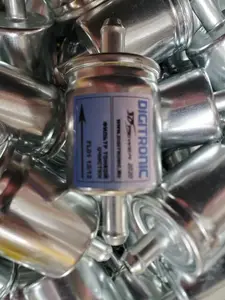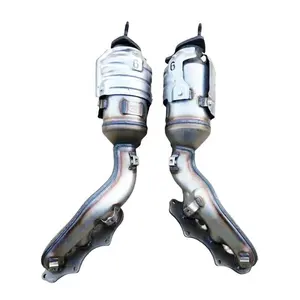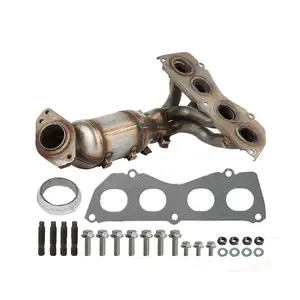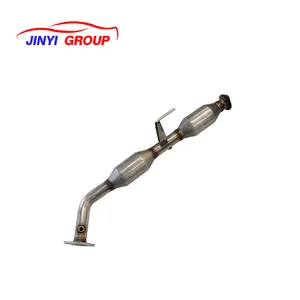A catalytic converter for California is an essential device in the automotive industry, specifically engineered to meet the stringent emissions regulations of the state. These converters play a pivotal role in reducing the environmental impact of vehicles by converting toxic pollutants from exhaust gases into less harmful substances.
Types of Catalytic Converters for California
The variety of catalytic converters for California includes options like two-way, three-way, and three-way with an oxidation (also known as a four-way) catalytic converter. Each type is designed to address specific pollutants. For instance, two-way converters primarily focus on carbon monoxide (CO) and hydrocarbons (HC), while three-way converters also reduce nitrogen oxides (NOx), a significant contributor to smog and acid rain. The California legal catalytic converter often refers to the three-way type, which is the most comprehensive in treating exhaust emissions to meet CARB standards.
Structure of California Catalytic Converters
The structure of a California cat converter is intricate, consisting of a core with a honeycomb structure that maximizes the surface area for the exhaust gases to pass through. This core is coated with a catalyst, typically made of precious metals like platinum, palladium, and rhodium. The exhaust gases react with these catalysts, triggering a chemical reaction that transforms harmful pollutants into harmless gases before they exit the vehicle's exhaust system. The efficiency of this process is crucial, as it directly impacts the vehicle's emissions and compliance with California's environmental regulations.
Materials and Their Properties
The materials used in a California emissions catalytic converter are selected for their ability to withstand extreme temperatures and chemical reactions. Stainless steel is commonly used for the body due to its durability and corrosion resistance. The catalyst materials, such as platinum, palladium, and rhodium, are chosen for their high reactivity. The use of 304 stainless steel, known for its high thermal conductivity and resistance to oxidation, ensures that the converter operates efficiently and has a long service life.
Business Usages and Applications
In the business realm, the California carb catalytic converter is crucial for automotive manufacturers, exhaust system producers, and aftermarket parts suppliers. These converters are used in various settings, from small automotive repair shops to large-scale vehicle manufacturing plants. They are instrumental in ensuring that vehicles comply with emissions regulations, which is not only a legal requirement but also a value proposition for environmentally conscious consumers. In commercial fleets, the use of certified converters can lead to significant savings in potential fines and contribute to corporate sustainability goals.
Functions of Catalytic Converters
The functions of a catalytic converter California approved unit are to reduce the emission of NOx, CO, and HC. This is achieved through two primary reactions: reduction, which removes nitrogen from NOx, and oxidation, which converts CO and HC into carbon dioxide (CO2) and water (H2O). These reactions are facilitated by the catalyst under high temperatures, typically present in the exhaust system.
Features of California Catalytic Converters
The features of a California catalytic converter include advanced coating technologies that enhance the efficiency of the catalytic reaction. Some converters also feature pre-catalysts that start the reaction sooner, reducing the time it takes for the converter to become effective after the engine starts. Additionally, the design of the honeycomb structure is optimized to provide the maximum surface area without creating excessive backpressure on the engine.
Benefits of Using a Compliant Catalytic Converter
The benefits of installing a California compliant catalytic converter are manifold. Beyond meeting legal requirements, these converters play a significant role in pollution reduction, contributing to cleaner air and a healthier environment. They also help maintain the vehicle's fuel efficiency and performance by ensuring that the exhaust system functions correctly.
How to Use and Maintain Your Catalytic Converter
Effective operation of a California emissions catalytic converter involves regular vehicle maintenance, such as timely oil changes and ensuring the engine is running efficiently. To maintain the converter, it is important to avoid using leaded fuels and to fix engine problems promptly, as these can damage the catalyst. Installation should be performed by a professional to ensure proper fitment and function.
How to Choose the Right Catalytic Converter
When selecting a catalytic converter for California, it is crucial to verify that it is CARB-compliant and suitable for the make and model of the vehicle. The choice may also depend on the specific needs, such as the type of fuel used and the typical driving conditions.
How to Clean and Install a Catalytic Converter
Cleaning a California cat converter typically requires a chemical cleaner designed for this purpose. However, physical cleaning is not often recommended, as it can damage the catalyst. Installation should align with the vehicle manufacturer's specifications and CARB regulations, and it is recommended to be carried out by a certified mechanic.
Target Audience and Their Needs
The target audience for a California legal catalytic converter includes vehicle owners in California, automotive repair shops, and fleet managers who must comply with CARB regulations. These converters are designed to meet the needs of this audience by providing a solution that ensures their vehicles are legally compliant and environmentally friendly.
What are the signs of a failing catalytic converter?
A failing catalytic converter for California may exhibit several signs, including reduced engine performance, increased fuel consumption, and a sulfur-like smell from the exhaust. The check engine light may also activate, indicating that the converter is not functioning efficiently and may need to be inspected or replaced.
Is it necessary to replace the catalytic converter with an OEM part?
While OEM parts are often recommended for their guaranteed fit and performance, there are aftermarket catalytic converter for California options that are CARB-compliant and can serve as cost-effective replacements. It is essential to ensure that any aftermarket part meets the required standards and comes with the necessary certifications.
How often should a catalytic converter be replaced?
The lifespan of a California carb catalytic converter can vary based on vehicle usage and maintenance. However, it is generally recommended to inspect the converter as part of regular vehicle maintenance. Replacement may be necessary if the converter is damaged or has reached the end of its service life, which is typically around 100,000 miles.
When sourcing a catalytic converter for California on Alibaba.com, it is crucial to consider these aspects to ensure that the product meets the necessary standards and requirements. Alibaba.com provides a platform for finding a wide range of certified and compliant catalytic converters suitable for various vehicles, ensuring that businesses can find the right components for their needs.












































 浙公网安备 33010002000092号
浙公网安备 33010002000092号 浙B2-20120091-4
浙B2-20120091-4